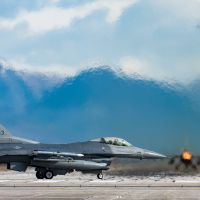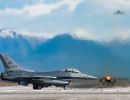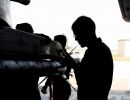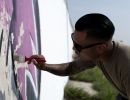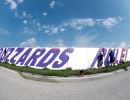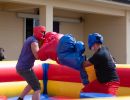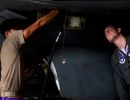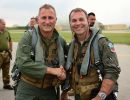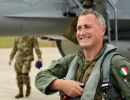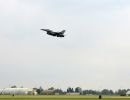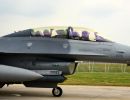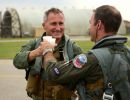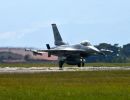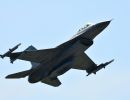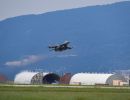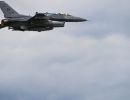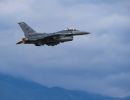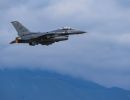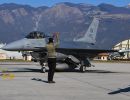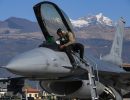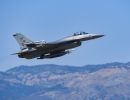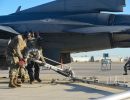HISTORY
of the
510TH TACTICAL FIGHTER SQUADRON
Ninth Air Force, Tactical Air Command
1 July – 30 September 1965
England Air Force Base
Alexandria, Louisiana
| GARY W. FREDRICKS Captain, USAF Historical Officer |
ALLEN S. NELSON Lt Col, USAF Commander |
FORWORD
This history is for the 510th Tactical Fighter Squadron for the 1 July – 30 September 1965 time period. The squadron remained deployed to Clark AB, Republic of the Philippines on a Cross Switch rotation until returning to England AFB, Louisiana on 20 August. Therefore, squadron energy was devoted to the operational commitment as well as to accomplishing flying training and maintaining weapons qualifications. This history offers a narrative report on squadron activities during the 3-month period. It first discusses the unit mission and administrative activities. After that, the various personnel changes are presented with emphasis on squadron augmentation. Then, the various operations and training that the 510th performed in order to fulfill its mission are discussed in detail. Finally, the report briefly describes the maintenance and supply activity of the unit during the period of the deployment. Like all histories, this one is subject to revision and corrections. All suggested corrections will be gratefully received and investigated.
CONTENTS
Forward
Chapter I
1 Mission
2 Organization
3 Administration
Chapter II
4. Personnel
Chapter III
5. Employment Operations
6. Redeployment
7. Operations and Training at England AFB
Chapter IV
8. Maintenance and Supply
Appendices
CHAPTER I
1. Mission:
During the first month and a half of the reporting period, the 510th Tactical Fighter Squadron was deployed to Clark AB, Republic of the Philippines, on a normal tactical rotation. For the period of the deployment, the unit mission was as follows: The primary mission of the 510th Tactical Fighter Squadron was to maintain a status of alert and combat readiness posture sufficient to destroy assigned targets within areas and time limitations directed by higher headquarters. The secondary mission was to conduct contingency operations and maneuvers throughout Southeast Asia, and to assume an air defense posture when offensive resources have been exhausted.1
When the squadron redeployed to its permanent duty station, England AFB, Louisiana, it reverted to operational control of its parent unit, the 3rd Tactical Fighter Wing. England AFB has been the permanent duty station of the 510th since 18 March 1964, when the unit arrived from Clark AB, Philippines, on a PCS move. The mission after the squadron returned on 20 August 1965, was to train and supply combat ready aircrews to the 3rd TFW for use in support of 834th Air Division missions.
These missions include the following:
a. Attacking and destroying enemy military forces, supplies, equipment, communications systems, and installations with nuclear and non-nuclear weapons.
b. Attacking and destroying targets in support of surface forces while engaged in joint operations.
c. Providing active air defense by engaging and destroying enemy air forces in either offensive or defensive roles by visual interception or under direction of air control and warning systems.2
2. Organization:
Squadron organization remained unchanged until 29 August 1965, when the 510 returned to England AFB from operation “Cross Switch”. At that time, the maintenance and other support personnel who had been augmenting the squadron rejoined their various wing organizations.
While deployed, the 510th operated under the single squadron concept, requiring a large augmentation group. The unit was headed by the squadron commander. His operations staff consisted of the operations officer, the assistant operations officer, and the standardization/evaluation officer. The squadron was assigned a first sergeant, a chief administrative technician, 2 administrative specialists, and a personnel specialist. In addition, a complete aircraft/flight line maintenance organization was assigned. This consisted of a maintenance supervisor officer, a flight line maintenance officer, a munitions officer, a maintenance line chief, and support personnel for maintenance of flight line operations. A flight surgeon and an intelligence officer were among the augmentees. The squadron aircrews were divided among 4 flights.
After returning to England, the organization reverted to normal status. It was headed by the squadron commander with his operations staff remaining unchanged. The squadron aircrews were still divided equally among the 4 flights.
3. Administration:
The administration of the squadron continued to operate smoothly throughout the period of the deployment. No significant problems arose that were not mentioned in the historical report from this unit.3
The situation was different, however, after the squadron’s arrival at England AFB. With the decrease of assigned personnel occurring at that time, the unit was left with only 1 administrative technician. This NCO has been undergoing treatment for a back problem since his return and 30 September was still hospitalized. The lack of an administrative technician imposed an additional work load on the 2 operations specialists as well as the aircraft crews.
CHAPTER II
4. Personnel:
The latest manning program for this unit calls for 1 commander, 3 officers on the operations staff, 23 aircraft crews, and 4 enlisted personnel.4 In addition to this, the squadron gained 1 maintenance supervisor officer, 1 flight line maintenance officer, 1 intelligence officer, 1 flight surgeon, 1 munitions officer, and 160 enlisted personnel when it was augmented for the rotation. When the 510th redeployed, it was short 3 aircraft crews and 4 enlisted personnel.
During the period of the deployment, the squadron staff remained unchanged. Lt Col Allen S. Nelson, FR37492, was commander. Major Elder E. C. Tetzlaff was operations officer, and his assistant was Major Eugene J. Russel. The stan/eval officer was Captain Robert W. Fizer. The flight commanders were as follows: “A” Flight, Captain J. O’Brien; “B” Flight, Captain J. C. Barnes; “C” Flight, Captain E. A. Kowalczyk; and “D” Flight, Captain W. A. Boyd. The staff gained through augmentation was listed: Major J. S. Benham, maintenance supervisor officer; 2nd Lt D. R. Manes, flight line maintenance officer; 1st Lt N. D. Echols, intelligence officer; 2nd Lt D. L. Dean, munitions officer; and Captain S. F. Weinstein, flight surgeon.
When the 510th returned to England AFB, the augmentees rejoined their former units. With the exception of 3 aircrews, the operations section of the squadron remaind intact throughout the period of this report. Cap W. A. Boyd, on 30 July, returned to England AFB because of his previous and consecutive TDY to Southeast Asia. He rejoined the squadron on its return to the ZI. When the squadron arrived at England AFB, Capt S. C. Humphries was reassigned to the 3rd TFW as the wing gunnery officer. Additionally, on 27 4 Machine run on Unit Manning Document. Sup doc Nr. 1, Tab A.
September, Capt R. E. Blood left the squadron for a PCS assignment. He will travel to Hurlburt AFB, Florida, for upgrading in the AIH aircraft prior to leaving for Viet Nam. A roster of squadron operations personnel as of 30 September 1965 is enclosed as an attachment to this report.5
CHAPTER III
5. Employment Operations:
The beginning of the reporting period found the 510th deployed to Clark AB, Philippines. The principal duty of the unit while there was in filling the 405th Fighter Wing commitment to the Single Integrated Operations Plan (SIOP), consisting of a Quick Strike force and a follow-on force. The Quick Strike force was composed of 4 aircraft, 6 aircrews, and support personnel at Tainan AS, Taiwan. The aircraft were kept on ground alert, loaded with nuclear weapons. Both aircraft and crews were rotated between Clark and Tainan on a weekly basis. While at Tainan, the aircrews rotated duty, having 4 crews on alert and 2 pilots off duty. The 4 alert crews maintained a 15-minute reaction time both day and night. Frequent practice alerts were conducted by detachment personnel to assure operational readiness.
Transportation between Clark and Tainan was still a problem, as it was during the last reporting period. The controlling agency for the courier used continued to change between base operations and MATS ATCO. This resulted in confusion for the units, including the 510th, that used this transportation.
The follow-on contingent to the SIOP was maintained at Clark AB. Under this commitment, 8 more sorties were targeted. Alert times for these sorties varied from 1 hour 10 minutes for the first 4 to 2:55 for the last one.
During the latter part of the employment, 510th aircraft were transferred to other units in Southeast Asia to replace combat losses. This continued until this squadron possessed only 13 aircraft at the end of the rotation period. With this number of aircraft, the squadron was hard pressed to maintain the SIOP commitment of 12 sorties. However, through superior scheduling and maintenance, the 510th was able to fulfill the commitment at all times.6
The 510th, additionally, conducted normal flying training at Clark AB. The unit flew 487.9 hours in July and 435.7 hours (including redeployment) in August. Various squadron aircrews also flew combat support missions. These missions came from ferrying F-100 aircraft from Clark to bases in Viet Nam. A photography mission using F-100F’s and lasting about 1 week in Viet Nam was also performed by the squadron.
On Sunday, 15 August, the 522nd Tactical Fighter Squadron, our replacement unit, arrived at Clark AB from Cannon AFB, New Mexico. Six aircrews and aircraft continued on to Tainan AS that same day. Briefings for crews at both Clark and Tainan were held on Monday, 16 August. That afternoon, after being relieved at Tainan, 510th crews ferried 2 Cannon aircraft and the four 510th aircraft back to Clark.
6. Redeployment:
The 510th began its return to England AFB on 17 August 1965. Four KC-135 tankers were used to refuel the 13 F-100’s during the redeployment. Additionally, 5 C-130 and 1 C-135 aircraft airlifted support personnel.
The first leg of the redeployment, from Clark to Guam, was flown in 2 waves of 8 and 5 fighters. On 19 August, after a 24-hour hold for an adverse weather forecast enroute, the aircraft launched for Hickam AFB, Hawaii. The only incident of the trip occurred on this leg, when an F-100 snapped off a refueling probe during air-to-air refueling. This caused 1 other fighter and 1 tanker to sympathetically abort back to Guam.
In a truly outstanding effort, maintenance crews repaired the aircraft and launched fighters and the tanker the following day.
On 20 August, after 36 hours of ground time for the first 11 fighters, all aircraft departed Hickam for England AFB. This leg ended just prior to dusk when the second cell landed at England. Remaining support personnel and equipment arrived on 21 August.7
7. Operations and Training at England AFB:
When the 510th returned to England AFB, virtually all aircrews took leave, averaging 14 days. After this, the unit returned to normal tactical flying and ground training.
On 3 September, Captain Gary W. McKillip left the squadron for a 14-week tour at Squadron Officer School (SOS), Maxwell AFB, Alabama. SOS, unlike most Air Force schools, is oriented to improving an officer’s professional competence, rather than his technical skills.
On 9 September, the squadron ferried aircraft to Cannon AFB, New Mexico, in a base wide evacuation from Hurricane Betsy. All aircraft and aircrews returned on 11 September. The only other operation the squadron participated in also involved ferrying aircraft. During the last part of September, various squadron crews took aircraft to Palmdale, California, for IRAN maintenance. As the period for this report closed, the squadron was well over 50% complete on flying training, semi-annual, requirements. These requirements are as follows:
| 2 VLADD 2 VLD 3 Dive Bomb 3 Dive bomb random 2 Low level bomb 1 GBU 3 LLB/CBU random 3 Rocketry 3 Rocketry random 3 Strafe 3 Strafe random 1 AGM-12 1 CAS w/Army 1 Sim CAS 2 A/C 1 LLV ATTK 4 A/C ordn 2 Trail Blazer 6 Aerial combat tactics 2 Dart 4 Low level nav 2 Visual recon 16 Gun Camera |
150 AGM-12 Sim 2 AAR Day 2 AAR Night 4 Toboggan 2 Instrument flight 2 Hooded LADD 2 Radar cont pent 2 UHF/DF pent & apr 6 ADF pent & apr 6 VORTAC pent & apr 18 GCA 2 GCA day full stop 2 GCA night full stop 2 GCA-Sim D/G-HIS out 2 Missed apr proc 2 Form ldg-day-wg or ld 2 Form ldg-night-wg or ld 2 Form day inst dept 2 Form night inst dept 2 Form day inst recov 2 Form night inst recov |
The only problem of consequence involving flying training at England was non-availability of AGM-12 missiles. Four crews in the squadron have never had the opportunity to fire this missile for qualification and 10 additional aircrews are nearing their dates for requalification. As this period closed, the unit still stymied in its requests for missile availability.
CHAPTER IV
8. Maintenance and Supply:
While TDY with a TAC Rote squadron, the maintenance complex was of the standard, single squadron concept. A materiel officer was overall supervisor. He had an aircraft maintenance officer to supervise the flight line and periodic maintenance function and an A&E maintenance officer to supervise the armament and electronics specialist areas. The supply supervisor, a sergeant, worked directly for the materiel officer. A scheduler, a records clerk, and a maintenance clerk were integrated into the 405th FW Chief of Maintenance functional areas.
The 405th DCM gave the senior TAC Rote F-100 maintenance officer at Clark the overall responsibility for monitoring all F-100 maintenance activities in SE Asia. Since Clark AB was the main operating base for F-100’s in SE Asia, this officer had overall responsibility for all Rote and CASF periodic maintenance functions. CASF units consolidated specialist packages to provide level work flow.
Field maintenance personnel and armament and electronic specialists were integrated into the 405th FMS and the 405th AES host organizations for dispatch and control. All significant maintenance problem areas noted during this deployment were previously discussed in this units last historical report. These items are all presented in Tab C of the TACOP final report for this unit found under Tab C of this report. A recapitulation of maintenance activity during the entire employment has been extracted and follows:
a. Average aircraft possessed...18
b. Average aircraft opl ready...15
c. Average OR rate..............79%
d. Average NORM.................6%
e. Average NORS.................15%
f. Hours flown 10 May–12 Aug....1586 hours
Appendices
A. Machine run on Unit Manning Document. Sup Doc Nr. 1.
B. Squadron roster of permanently assigned personnel. (Officer)
C. TACOP Final Report of the 510th TFS Operations Cross Switch. (Omitted from this transcribed report. See separate transcribed document for this report.)
| 0510 TFSG SQ ENGLAND AFB LA | ||||||||||
| 3/65 | 4/65 | 1/66 | 2/66 | 3/66 | ||||||
| 310001 | UNIT COMMAND*TACSQ | |||||||||
| PILOT TACT FIGHTER | LTC | X | 3 | 11158 | 1 | 1 | 1 | 1 | 1 | |
| 1 | 1 | 1 | 1 | 1 | ||||||
| 310002 | UNIT ADMIN*TACSQ | |||||||||
| FIRST SERGEANT | MSG | 01090 | 1 | 1 | 1 | 1 | 1 | |||
| ADMINISTRATIVE SP | AIC | 70250 | 1 | 1 | 1 | 1 | 1 | |||
| 2 | 2 | 2 | 2 | 2 | ||||||
| 310003 | AIRCRAFT CPNS | |||||||||
| OPNS OFFICER | LTC | X | 3 | 11158 | 1 | 1 | 1 | 1 | 1 | |
| FAC | LT | 1 | 11158 | 1 | 1 | 1 | 1 | 1 | ||
| FAC | CPT | 1 | 11158 | 1 | 1 | 1 | 1 | 1 | ||
| AIR CPER SUPV | TSG | 27170 | 1 | 1 | 1 | 1 | 1 | |||
| ADMINISTRATIVE SP | A1C | 70250 | 1 | 1 | 1 | 1 | 1 | |||
| 5 | 5 | 5 | 5 | 5 | ||||||
| 311000 | AIRCRAFT CREW | |||||||||
| PILOT TACT FIGHTER | LT | 1 | 11158 | 4 | 4 | 4 | 4 | 4 | ||
| PILOT TACT FIGHTER | CPT | 1 | 11158 | 1 | 1 | 1 | 1 | 1 | ||
| PILOT TACT FIGHTER | MAJ | 1 | 11158 | 4 | 4 | 4 | 4 | 4 | ||
| PILOT TACT FIGHTE R | LTC | 1 | 11158 | 3 | 3 | 3 | 3 | 3 | ||
| FAC | LT | 1 | P 11158 | 5 | 5 | 5 | 5 | 5 | ||
| FAC | CPT | 1 | P 11158 | 5 | 5 | 5 | 5 | 5 | ||
| PILOT TACT FIGHTE R | CPT | 1 | S 11158 | 1 | 1 | 1 | 1 | 1 | ||
| 23 | 23 | 23 | 23 | 23 | ||||||
| GRADE RECAP | LTC | 5 | 5 | 5 | 5 | 5 | ||||
| MAJ | 4 | 4 | 4 | 4 | 4 | |||||
| CPT | 8 | 8 | 8 | 8 | 8 | |||||
| LT | 10 | 10 | 10 | 10 | 10 | |||||
| 27 | 27 | 27 | 27 | 27 | ||||||
| MSG | 1 | 1 | 1 | 1 | 1 | |||||
| TSG | 1 | 1 | 1 | 1 | 1 | |||||
| A1C | 2 | 2 | 2 | 2 | 2 | |||||
| 4 | 4 | 4 | 4 | 4 | ||||||
| 31 | 31 | 31 | 31 | 31 | ||||||
SQUADRON ROSTER |
||
| TITLE | RANK | NAME |
| Commander | Lt Colonel | Nelson, Allen S |
| Operations Officer | Major | Tetzlaff, Elder E. C. |
| Assistant Ops Off | " | Russel, Eugene J. |
| Stan/Eval Officer | Captain | Fizer, Robert W. |
| Flight Commander | " | O’Brien, James |
| " | Barnes, James C. | |
| " | Kowalczyk, Edward A. | |
| " | Boyd, Willie A. | |
| Pilot | " | Conway, Bernard M. |
| " | Craig, Charles R. | |
| " | Foy, James C. | |
| " | Findlay, Gary W. | |
| " | Fredricks, Gary W. | |
| " | Gellings, Edward A. | |
| " | Greco, Joseph J. | |
| " | Guin, Bob W. | |
| " | Gundlach, Earl R. | |
| " | Knox, Edward L. | |
| " | Krueger, Lorin S. II | |
| " | Mason, William D. | |
| " | McKillip, Gary W. | |
| " | Richards, Roger N. | |
| " | Wagner, Paul E. | |
TACOP Final Report of the 510th TFS Operations Cross Switch.
See separate transcribed report.
FOOTNOTES
1 - 510th Tactical Fighter Squadron unit history 16 March 1964. Secret. Mission statement is unclassified.
2 - TACR 23-42, Organizational and Mission-Field, 834th AIR DIVISION – FIGHTER. Langley AFB, Virginia, Hq Tactical Air Command, 31 August 1964.
3 - 510th TFS unit history for April – 30 June 1965. Secret
6 - 510th TACOP Final Report, Secret See Tab C of this report.
7 - 510th TFS TACOP Final Report. Secret. See Tab C of this report.
196


